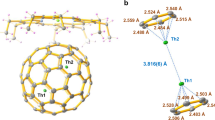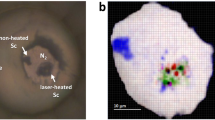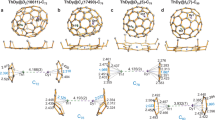Abstract
Curium is unique in the actinide series because its half-filled 5f 7 shell has lower energy than other 5f n configurations, rendering it both redox-inactive and resistant to forming chemical bonds that engage the 5f shell1,2,3. This is even more pronounced in gadolinium, curium’s lanthanide analogue, owing to the contraction of the 4f orbitals with respect to the 5f orbitals4. However, at high pressures metallic curium undergoes a transition from localized to itinerant 5f electrons5. This transition is accompanied by a crystal structure dictated by the magnetic interactions between curium atoms5,6. Therefore, the question arises of whether the frontier metal orbitals in curium(iii)–ligand interactions can also be modified by applying pressure, and thus be induced to form metal–ligand bonds with a degree of covalency. Here we report experimental and computational evidence for changes in the relative roles of the 5f/6d orbitals in curium–sulfur bonds in [Cm(pydtc)4]− (pydtc, pyrrolidinedithiocarbamate) at high pressures (up to 11 gigapascals). We compare these results to the spectra of [Nd(pydtc)4]− and of a Cm(iii) mellitate that possesses only curium–oxygen bonds. Compared with the changes observed in the [Cm(pydtc)4]− spectra, we observe smaller changes in the f–f transitions in the [Nd(pydtc)4]− absorption spectrum and in the f–f emission spectrum of the Cm(iii) mellitate upon pressurization, which are related to the smaller perturbation of the nature of their bonds. These results reveal that the metal orbital contributions to the curium–sulfur bonds are considerably enhanced at high pressures and that the 5f orbital involvement doubles between 0 and 11 gigapascal. Our work implies that covalency in actinides is complex even when dealing with the same ion, but it could guide the selection of ligands to study the effect of pressure on actinide compounds.
This is a preview of subscription content, access via your institution
Access options
Access Nature and 54 other Nature Portfolio journals
Get Nature+, our best-value online-access subscription
$29.99 / 30 days
cancel any time
Subscribe to this journal
Receive 51 print issues and online access
$199.00 per year
only $3.90 per issue
Buy this article
- Purchase on Springer Link
- Instant access to full article PDF
Prices may be subject to local taxes which are calculated during checkout




Similar content being viewed by others
Data availability
Crystallographic information files have been deposited in the Cambridge Crystallographic Data Centre (CCDC; https://www.ccdc.cam.ac.uk/structures/) with deposition numbers 1927752 (Cm-1), 1927751 (Cm-2) and 1930252 (Nd-1).
References
Wybourne, B. G. Spectroscopic Properties of Rare Earths (Wiley, 1965).
Silver, M. A. et al. Electronic structure and properties of berkelium iodates. J. Am. Chem. Soc. 139, 13361–13375 (2017).
Bagus, P. S., Ilton, E. S., Martin, R. L., Jensen, H. J. A. & Knecht, S. Spin–orbit coupling in actinide cations. Chem. Phys. Lett. 546, 58–62 (2012).
Edelstein, N. M., Klenze, R., Fanghänel, T. & Hubert, S. Optical properties of Cm(iii) in crystals and solutions and their application to Cm(iii) speciation. Coord. Chem. Rev. 250, 948–973 (2006).
Heathman, S. et al. A high-pressure structure in curium linked to magnetism. Science 309, 110–113 (2005).
Moore, K. et al. Emergence of strong exchange interaction in the actinide series: the driving force for magnetic stabilization of curium. Phys. Rev. Lett. 98, 236402 (2007).
Cary, S. K. et al. A series of dithiocarbamates for americium, curium, and californium. Dalton Trans. 47, 14452–14461 (2018).
Carnall, W. T. & Fields, P. A study of the complexes of curium (iii) by absorption spectrometry. J. Am. Chem. Soc. 81, 4445–4449 (1959).
Carnall, W. T. & Wybourne, B. G. Electronic energy levels of the lighter actinides: U3+, Np3+, Pu3+, Am3+, and Cm3+. J. Chem. Phys. 40, 3428–3433 (1964).
Carnall, W. T. & Rajnak, K. Electronic energy level and intensity correlations in the spectra of the trivalent actinide aquo ions. II. Cm3+. J. Chem. Phys. 63, 3510–3514 (1975).
Kolbe, W., Edelstein, N. M., Finch, C. & Abraham, M. Zero-field splittings of Gd3+ and Cm3+ in CeO2 and ThO2. J. Chem. Phys. 58, 820–821 (1973).
Kim, J., Klenze, R. & Wimmer, H. Fluorescence spectroscopy of curium(iii) and application. Eur. J. Solid State Inorg. Chem. 28, 347–356 (1991).
Yusov, A. Luminescence of transplutonium elements in solutions and its application. Radiokhimiya 35, 1–14 (1993).
Dachille, F. & Roy, R. High-pressure phase transformations in laboratory mechanical mixers and mortars. Nature 186, 34–71 (1960).
Perdew, J. P. et al. Restoring the density-gradient expansion for exchange in solids and surfaces. Phys. Rev. Lett. 100, 136406 (2008).
Jung, J., Atanasov, M. & Neese, F. Ab initio ligand-field theory analysis and covalency trends in actinide and lanthanide free ions and octahedral complexes. Inorg. Chem. 56, 8802–8816 (2017).
Murdoch, K., Nguyen, A., Edelstein, N., Hubert, S. & Ga, J. Two-photon absorption spectroscopy of Cm3+ in LuPO4. Phys. Rev. B 56, 3038–3045 (1997).
Illemassene, M., Murdoch, K., Edelstein, N. & Krupa, J. Optical spectroscopy and crystal field analysis of Cm3+ in LaCl3. J. Lumin. 75, 77–87 (1997).
Sytsma, J., Murdoch, K., Edelstein, N. M., Boatner, L. & Abraham, M. Spectroscopic studies and crystal-field analysis of Cm3+ and Gd3+ in LuPO4. Phys. Rev. B 52, 12668 (1995).
da Luz, L. L. et al. Inkjet printing of lanthanide-organic frameworks for anti-counterfeiting applications. ACS Appl. Mater. Interfaces 7, 27115–27123 (2015).
Sheldrick, G. SHELXT – integrated space-group and crystal-structure determination. Acta Crystallogr. A 71, 3–8 (2015).
Dolomanov, O. V., Bourhis, L. J., Gildea, R. J., Howard, J. A. K. & Puschmann, H. OLEX2: a complete structure solution, refinement and analysis program. J. Appl. Crystallogr. 42, 339–341 (2009).
Milburn, G. International tables for X-ray crystallography. Acta Crystallogr. B 32, 2732 (1983).
Spek, A. L. PLATON SQUEEZE: a tool for the calculation of the disordered solvent contribution to the calculated structure factors. Acta Crystallogr. C 71, 9–18 (2015).
Chijioke, A. D., Nellis, W., Soldatov, A. & Silvera, I. F. The ruby pressure standard to 150 GPa. J. Appl. Phys. 98, 114905 (2005).
Kresse, G. & Hafner, J. Ab initio molecular dynamics for liquid metals. Phys. Rev. B 47, 558 (1993).
Blöchl, P. E. Projector augmented-wave method. Phys. Rev. B 50, 17953 (1994).
Baerends, E. J. et al. Amsterdam Density Functional v.2017 (SCM, 2017).
Perdew, J. P., Burke, K. & Ernzerhof, M. Generalized gradient approximation made simple. Phys. Rev. Lett. 77, 3865 (1996).
Stephens, P. J., Devlin, F. J., Chabalowski C. F. & Frisch, M. J. Ab initio calculation of vibrational absorption and circular dichroism spectra using density functional force fields. J. Phys. Chem. 98, 11623–11627 (1994).
Adamo, C. & Barone, V. Toward reliable density functional methods without adjustable parameters: the PBE0 model. J. Chem. Phys. 110, 6158 (1999).
van Lenthe, E., Baerends, E. J. & Snijders, J. G. Relativistic regular two-component Hamiltonians. J. Chem. Phys. 99, 4597 (1993).
Glendening, E. D., Landis, C. R. & Weinhold, F. NBO 6.0: natural bond orbital analysis program. J. Comput. Chem. 34, 1429–1437 (2013).
Aquilante, F. et al. Molcas 8: new capabilities for multiconfigurational quantum chemical calculations across the periodic table. J. Comput. Chem. 37, 506–541 (2016).
Roos, B. O., Taylor, P. R. & Si, P. E. A complete active space SCF method (CASSCF) using a density matrix formulated super-CI approach. Chem. Phys. 48, 157–173 (1980).
Gagliardi, L. et al. Multiconfiguration pair-density functional theory: a new way to treat strongly correlated systems. Acc. Chem. Res. 50, 66–73 (2017).
Sergentu, D.-C., Duignan, T. J. & Autschbach, J. Ab initio study of covalency in the ground versus core-excited states and X-ray absorption spectra of actinide complexes. J. Chem. Phys. Lett. 9, 5583–5591 (2018).
Neese, F. Software update: the ORCA program system, version 4.0. Wiley Interdiscip. Rev. Comput. Mol. Sci. 8, e1327 (2018).
Keith, T. AIMA11 (TK Gristmill Software, 2017).
Espinosa, E., Alkorta, I., Elguero, J. & Molins, E. From weak to strong interactions: a comprehensive analysis of the topological and energetic properties of the electron density distribution involving X−H ∙∙∙ F−Y systems. J. Chem. Phys. 117, 5529–5542 (2002).
Neidig, M. L., Clarck, D. L. & Martin, R. L. Covalency in f-element complexes. Coord. Chem. Rev. 257, 394–406 (2013).
Kerridge, A. Quantification of f-element covalency through analysis of the electron density: insights from simulation. Chem. Commun. 53, 6685–6695 (2017).
Lu, E. et al. Emergence of the structure-directing role of f-orbital overlap-driven covalency. Nat. Commun. 10, 634 (2019).
Speldrich, M., val Leusen, J. & Kögerler, P. CONDON 3.0: an updated software package for magnetochemical analysis-all the way to polynuclear actinide complexes. J. Comput. Chem. 39, 2133–2145 (2018).
Acknowledgements
All experimental studies and the high-pressure molecular geometry and electronic structure calculations were supported by the US Department of Energy, Office of Science, Office of Basic Energy Sciences, Heavy Elements Chemistry Program under award numbers DE-FG02-13ER16414 (T.E.A.-S.) and DE-SC0001136 (J.A.). Theoretical studies after high-pressure evaluation were supported by the US Department of Energy through the Center for Actinide Science and Technology (CAST) funded by the Energy Frontiers Research Program under award number DE-SC0016568. We are grateful for the assistance and supervision of the Office of Environmental Health and Safety at Florida State University, specifically J. A. Johnson and A. L. Gray of the Office of Radiation Safety for their facilitation of these studies. D.-C.S., X.W., E.Z. and J.A. thank the Center for Computational Research (CCR) at the University at Buffalo for providing computational resources. E.Z. acknowledges the NSF (DMR-1827815) for financial support.
Author information
Authors and Affiliations
Contributions
J.M.S., E.J.W., B.E.K., C.J.W., A.N.G., F.D.W., A.T.C., M.A.W., B.N.L., D.A.B., K.H. and T.E.A.-S. conceived, designed and carried out the synthetic, spectroscopic, crystallographic and high-pressure experiments. P.K., M.S., D.-C.S., C.C.-B., X.W., E.Z. and J.A. carried out the quantum mechanical calculations. All authors discussed and co-wrote the manuscript.
Corresponding authors
Ethics declarations
Competing interests
The authors declare no competing interests.
Additional information
Peer review information Nature thanks Olle Eriksson, Stephen Moggach and Tonya Vitova for their contribution to the peer review of this work.
Publisher’s note Springer Nature remains neutral with regard to jurisdictional claims in published maps and institutional affiliations.
Extended data figures and tables
Extended Data Fig. 1 Absorbance spectra as a function of pressure.
a, f–f transitions in Cm-1 spectra show large bathochromic shifts as pressure is applied; however, the pydtc− ligand-based broadband absorption quickly obscures the Cm3+ transitions. b, In Cm-2, these transitions are not competing with any broadband ligand-based transitions; however, the f–f transitions show much smaller shifts up to high pressures than those observed for Cm-1. c, The shifts observed in Nd-1, the Nd3+ analogue of Cm-1, are more similar to those of Cm-2 than those of Cm-1.
Extended Data Fig. 2 Photoluminescence data for Cm-1 and Cm-2.
a, b, Phosphorescence spectra of Cm-2 as a function of temperature (a) and pressure (b) (λex = 420 nm). c, d, Emission decay curves (λex = 443 nm, λem = 609 nm) for Cm-1 (c) and Cm-2 (d) (λex = 434 nm, λem = 596 nm). Even at low temperatures the Stark levels are not clearly resolved in Cm-2. Pressure does not induce considerable broadening, and only minor bathochromic shifts are observed. Cm-1 has a weighted lifetime of 92 μs and Cm-2 has a lifetime of 18 μs. The longer lifetime of Cm-1 compared to Cm-2 is reflected in the increased intensity of the emission.
Extended Data Fig. 3 Depiction of two-centre two-electron σ(Cm–S) NLMOs.
a, NLMOs (isosurface of ±0.02) obtained from the MC-pDFT+SO/tPBE wavefunctions of the lowest-energy components of the 8S7/2 ground state and the photoluminescent 6D7/2 state of Cm-1 at 0 GPa (left) and 11 GPa (right). NLMO compositions (averaged over the eight Cm–S bonds), aggregate Cm Wiberg bond index (WBI) and NLMO/NPA-based effective bond order (EBONLMO/NPA, obtained from the NLMO shared occupancies and bonding–antibonding overlap) (NPA, natural population analysis). b, NLMOs, aggregate Cm WBI and EBONLMO/NPA of the 8S7/2 ground state of Cm-2 (theoretical model).
Extended Data Fig. 4 Reaction and crystal images.
a, b, The reaction of Cm3+ before (a) and after (b) the addition of [NH4][pydtc]. c, Single crystal upon excitation with 420-nm light at 20 °C (bottom), −80 °C (middle) and −180 °C (top). d, e, Cm-1 crystals before (d) and during (e) excitation with 420-nm light. f, g, Single crystals before (f) and during (g) irradiation with 420-nm light. h, The reaction vial of Cm-2. i, Cm-2 crystal under 420-nm light at 20 °C (left), −80 °C (middle) and −180 °C (right).
Extended Data Fig. 5 Computational models and actual structure of Cm-2.
Geometry of Cm-2 units (nine-coordinated Cm by three mellitate ligands and four water ligands) at 0 GPa (left, wire frame) and 7 GPa (right, wire frame) superimposed with model geometry Cm-2′ (‘balls & sticks’). The model geometries retain the original Cm coordination while substituting the mellitate C6(CO2)4 terminals by CF3. The model geometries were used for MC-pDFT+SO calculations and DFT ground-state bonding analyses.
Extended Data Fig. 6 Temperature dependence of μeff of Cm-1.
Two different pressures are shown, 0 GPa (red line) and 8.0 GPa (blue line). Inset, total ligand-field splitting of the 8S7/2 term (left; red, 0 GPa; blue 8 GPa) and total splitting of the first excited 6D7/2 term (right; red, 0 GPa; blue, 8 GPa; black, calculated energies).
Supplementary information
Supplementary Information
This file contains Supplementary Figures 1-6 and Supplementary Table 1.
Rights and permissions
About this article
Cite this article
Sperling, J.M., Warzecha, E.J., Celis-Barros, C. et al. Compression of curium pyrrolidine-dithiocarbamate enhances covalency. Nature 583, 396–399 (2020). https://doi.org/10.1038/s41586-020-2479-2
Received:
Accepted:
Published:
Issue Date:
DOI: https://doi.org/10.1038/s41586-020-2479-2
This article is cited by
-
Theoretical study on the bonding and extraction properties of actinide (III) ions by 3,3′-sulfonyldithiophene, an O-donor ligand based on tetrahedral bonding S center
Structural Chemistry (2024)
-
Altering the spectroscopy, electronic structure, and bonding of organometallic curium(III) upon coordination of 4,4′−bipyridine
Nature Communications (2023)
-
Cyclopentadienyl coordination induces unexpected ionic Am−N bonding in an americium bipyridyl complex
Nature Communications (2022)
-
Polyoxometalates as ligands to synthesize, isolate and characterize compounds of rare isotopes on the microgram scale
Nature Chemistry (2022)
-
Covalent bond shortening and distortion induced by pressurization of thorium, uranium, and neptunium tetrakis aryloxides
Nature Communications (2022)
Comments
By submitting a comment you agree to abide by our Terms and Community Guidelines. If you find something abusive or that does not comply with our terms or guidelines please flag it as inappropriate.



